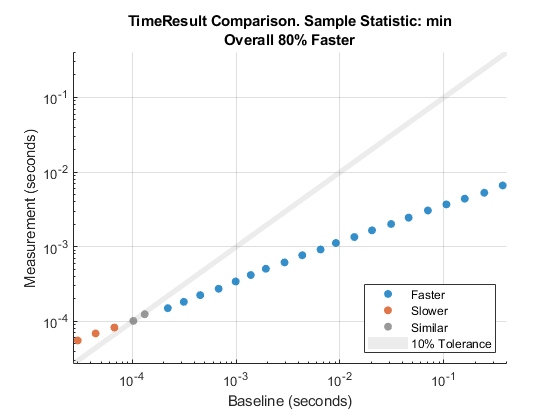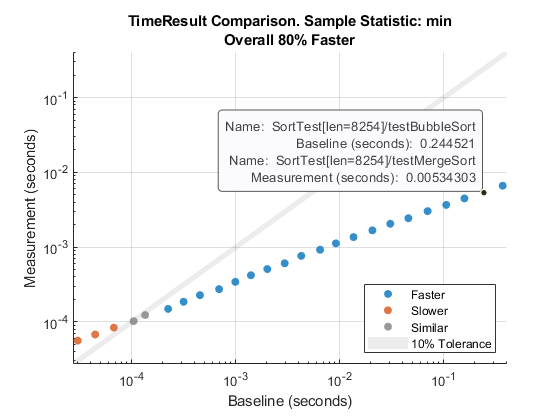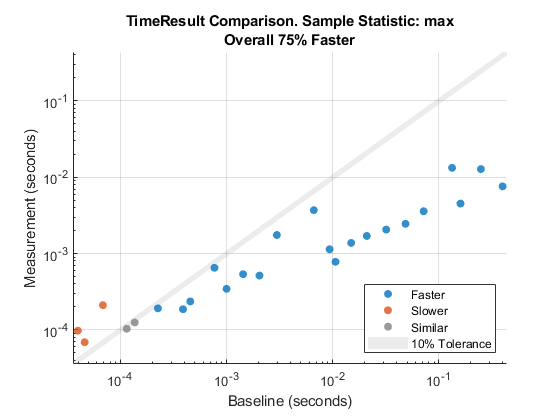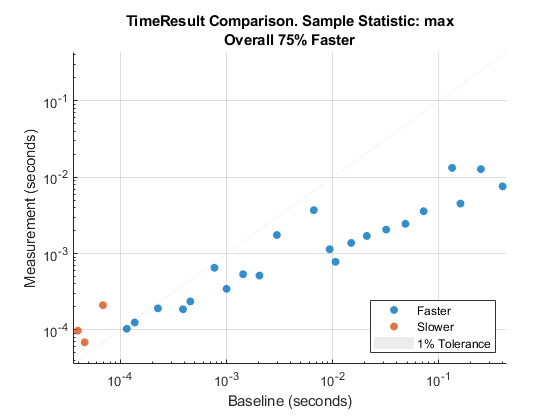comparisonPlot
类: matlab.perftest.TimeResult
命名空间: matlab.perftest
创建绘图来比较基线和测量测试结果
语法
说明
cp = comparisonPlot( 使用最小样本测量时间创建一个绘图,直观地比较 baseline,measurement)baseline 和 measurement 数组中的每个 TimeResult 对象。该方法将比较图以 matlab.unittest.measurement.chart.ComparisonPlot 对象形式返回。
cp = comparisonPlot( 使用指定的统计量创建一个比较图。baseline,measurement,stat)
cp = comparisonPlot(___, 支持上述语法中的任何输入参量组合,且可使用一个或多个名称-值参量指定选项。例如,Name,Value)cp = comparisonPlot(baseline,measurement,"Scale","linear") 使用带线性刻度的 x 轴和 y 轴创建一个绘图。
输入参数
对测试套件运行主计时试验的结果,指定为 matlab.perftest.TimeResult 数组。baseline 的长度必须与 measurement 的长度相同。
对测试套件运行次计时试验的结果,指定为 matlab.perftest.TimeResult 数组。measurement 的长度必须与 baseline 的长度相同。
应用于 baseline 和 measurement 中每个 TimeResult 对象的样本测量时间的统计数据,指定为 "min"、"max"、"mean" 或 "median"。
数据类型: string | char
名称-值参数
以 Name1=Value1,...,NameN=ValueN 的形式指定可选参量对组,其中 Name 是参量名称,Value 是对应的值。名称-值参量必须出现在其他参量之后,但参量对组的顺序无关紧要。
示例: cp = comparisonPlot(baseline,measurement,SimilarityTolerance=0.05,Scale="linear")
在 R2021a 之前,使用逗号分隔每个名称和值,并用引号将 Name 引起来。
示例: cp = comparisonPlot(baseline,measurement,"SimilarityTolerance",0.05,"Scale","linear")
比较图的 x 和 y 轴的刻度,指定为 "log" 或 "linear"。
数据类型: string | char
一对相似性能测试的统计量比率相对于 1 的允许偏差,指定为 0 和 1 之间的数值。
SimilarityTolerance 指定比较图中阴影区域的边界。该区域内的数据点表示相似的 baseline 和 measurement 项。
要在其中绘图的父容器,指定为 Figure、Panel、Tab 或 TiledChartLayout 对象。
示例
可视化两种排序算法(气泡排序和合并排序)的计算复杂度,这两种算法按升序对列表元素进行排序。气泡排序是一种简单的排序算法,它重复遍历列表,比较相邻的一对元素,并在元素顺序错误时交换元素。合并排序是一种“分而治之”的算法,它将排序的子列表合并为新排序列表,利用了这一机制的便捷性。
在当前文件夹中名为 bubbleSort.m 的文件中,创建 bubbleSort 函数,该函数实现气泡排序算法。
function y = bubbleSort(x) % Sorting algorithm with O(n^2) complexity n = length(x); swapped = true; while swapped swapped = false; for i = 2:n if x(i-1) > x(i) temp = x(i-1); x(i-1) = x(i); x(i) = temp; swapped = true; end end end y = x; end
在当前文件夹中名为 mergeSort.m 的文件中,创建 mergeSort 函数,该函数实现合并排序算法。
function y = mergeSort(x) % Sorting algorithm with O(n*logn) complexity y = x; % A list of one element is considered sorted if length(x) > 1 mid = floor(length(x)/2); L = x(1:mid); R = x((mid+1):end); % Sort left and right sublists recursively L = mergeSort(L); R = mergeSort(R); % Merge the sorted left (L) and right (R) sublists i = 1; j = 1; k = 1; while i <= length(L) && j <= length(R) if L(i) < R(j) y(k) = L(i); i = i + 1; else y(k) = R(j); j = j + 1; end k = k + 1; end % At this point, either L or R is empty while i <= length(L) y(k) = L(i); i = i + 1; k = k + 1; end while j <= length(R) y(k) = R(j); j = j + 1; k = k + 1; end end end
在当前文件夹中名为 SortTest.m 的文件中,创建 SortTest 参数化测试类,该类比较气泡排序和合并排序算法的性能。该类的 len 属性包含要用于测试的列表元素的数量。
classdef SortTest < matlab.perftest.TestCase properties Data SortedData end properties (ClassSetupParameter) % Create 25 logarithmically spaced values between 10^2 and 10^4 len = num2cell(round(logspace(2,4,25))); end methods (TestClassSetup) function ClassSetup(testCase,len) orig = rng; testCase.addTeardown(@rng,orig) rng("default") testCase.Data = rand(1,len); testCase.SortedData = sort(testCase.Data); end end methods (Test) function testBubbleSort(testCase) while testCase.keepMeasuring y = bubbleSort(testCase.Data); end testCase.verifyEqual(y,testCase.SortedData) end function testMergeSort(testCase) while testCase.keepMeasuring y = mergeSort(testCase.Data); end testCase.verifyEqual(y,testCase.SortedData) end end end
对所有对应于 testBubbleSort 方法的测试运行性能测试,并将结果保存在 baseline 数组中。您的结果可能与所示的结果不同。
baseline = runperf("SortTest","ProcedureName","testBubbleSort");
Running SortTest .......... .......... .......... .......... .......... .......... .......... .......... .......... .......... .......... .......... .......... .......... .......... .......... .......... .......... .......... .......... .......... .......... .......... .......... .......... .......... .......... .......... .......... .. Done SortTest __________
对所有对应于 testMergeSort 方法的测试运行性能测试,并将结果保存在 measurement 数组中。
measurement = runperf("SortTest","ProcedureName","testMergeSort");
Running SortTest .......... .......... .......... .......... .......... .......... .......... .......... .......... .......... .......... .......... .......... .......... .......... .......... .......... .......... .......... .......... .......... .......... .......... .......... .......... .......... .......... .......... .......... .......... .......... .......... .......... .......... .......... .......... .......... .......... .......... .......... .......... .......... .......... .......... .......... .......... .......... .......... .......... .......... .......... .......... .......... .......... .......... .......... .......... .......... .......... .......... .......... .......... .......... .......... .......... .......... .......... .......... .......... .......... .......... .......... .......... .......... .......... .......... .......... .......... .......... .......... .......... ..... Done SortTest __________
对于每组 baseline 和 measurement 对象,直观地比较其 Samples 表中对应 MeasuredTime 列的最小值。在此比较图中,大部分数据点为蓝色,因为它们位于阴影区域(表示相似)的下方。此结果表明,对于大多数测试来说,合并排序性能更优。但是,对于足够小的列表,气泡排序相比合并排序表现相当或更好,如图中橙色和灰色点所示。作为比较汇总,该图报告合并排序比气泡排序快 80%。该值是对应于所有数据点的提升百分比的几何均值。
cp = comparisonPlot(baseline,measurement);

您可以用鼠标点击或指向任何数据点,进一步了解正在比较的时间测量结果。

要研究不同列表长度下的最差情形排序算法性能,请根据样本测量时间的最大值创建比较图。
cp = comparisonPlot(baseline,measurement,"max");
在比较样本测量时间的最大值时,将相似性容差减少到 0.01。
cp = comparisonPlot(baseline,measurement,"max","SimilarityTolerance",0.01);

版本历史记录
在 R2019b 中推出
MATLAB Command
You clicked a link that corresponds to this MATLAB command:
Run the command by entering it in the MATLAB Command Window. Web browsers do not support MATLAB commands.
选择网站
选择网站以获取翻译的可用内容,以及查看当地活动和优惠。根据您的位置,我们建议您选择:。
您也可以从以下列表中选择网站:
如何获得最佳网站性能
选择中国网站(中文或英文)以获得最佳网站性能。其他 MathWorks 国家/地区网站并未针对您所在位置的访问进行优化。
美洲
- América Latina (Español)
- Canada (English)
- United States (English)
欧洲
- Belgium (English)
- Denmark (English)
- Deutschland (Deutsch)
- España (Español)
- Finland (English)
- France (Français)
- Ireland (English)
- Italia (Italiano)
- Luxembourg (English)
- Netherlands (English)
- Norway (English)
- Österreich (Deutsch)
- Portugal (English)
- Sweden (English)
- Switzerland
- United Kingdom (English)